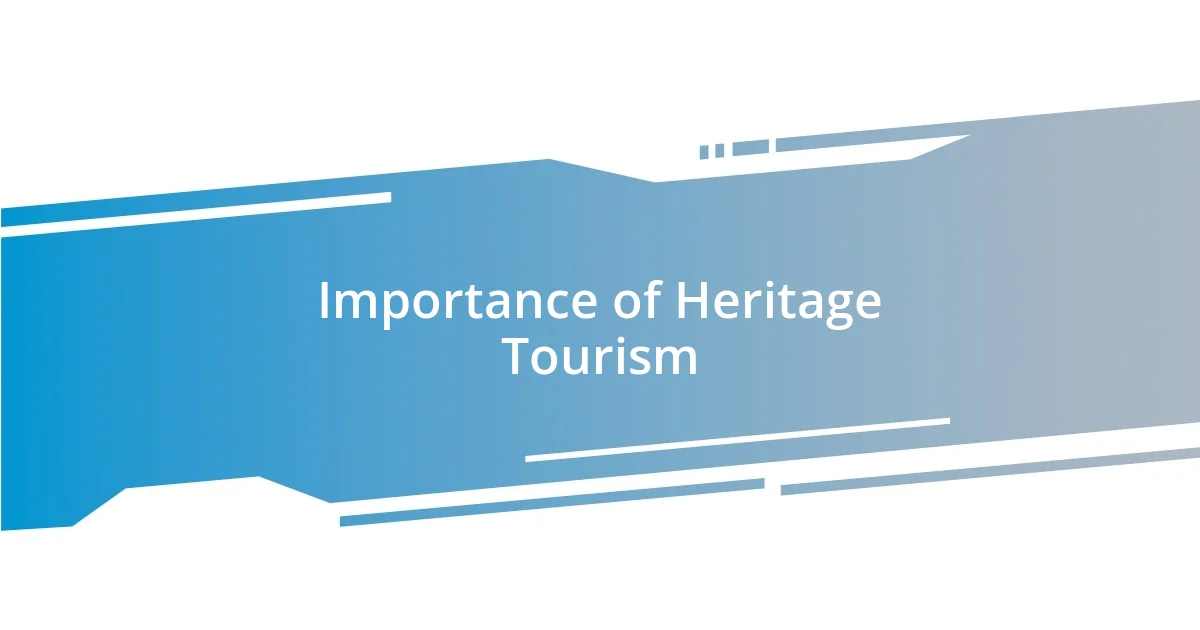Key takeaways:
- Exploring heritage sites deepens personal connections to history, fostering empathy and appreciation for cultural narratives.
- Heritage tourism preserves cultural identity and supports local economies while invoking emotional connections to traditions and values.
- Engaging in responsible travel practices, such as supporting local businesses and respecting customs, enhances the heritage site experience and promotes sustainability.

Exploring Local Heritage Sites
Exploring local heritage sites has a unique way of igniting my curiosity and appreciation for history. I remember wandering through an old castle in my hometown, marveling at the intricate stonework and imagining the lives of those who walked its halls centuries ago. Isn’t it fascinating how these sites allow us to step back in time and connect with our ancestors?
On another occasion, I stumbled upon a hidden museum tucked away in a quiet neighborhood. As I browsed through photographs and artifacts, I felt a rush of connection to the community’s past. What stories do these objects tell? It’s in those tangible pieces of history that I often find myself reflecting on the resilience and creativity of those who came before us.
Every visit to a heritage site brings a new discovery, both about the place and about myself. I recall a day spent at a historic battleground, where I not only learned about local conflicts but also felt a profound sense of empathy for the struggles experienced there. Can heritage sites reshape our understanding of who we are today? I believe they can, offering insights that resonate deeply within us, making history feel relevant and alive.

Importance of Heritage Tourism
Heritage tourism plays a pivotal role in preserving cultural identity. Recently, I visited a beautifully restored historic village, where each building told a story of the community’s past. It struck me how vital these sites are for maintaining traditions that might otherwise fade away. How does a place keep its essence alive? By welcoming visitors, these sites share their narratives, ensuring they are cherished for generations to come.
Moreover, heritage tourism can significantly boost local economies. During my visit to a quaint town known for its historic architecture, I noticed bustling shops and vibrant eateries, all thriving thanks to heritage travelers. Seeing the local artisans showcase their crafts heightened my appreciation for the unique cultural fabric they weave. Isn’t it rewarding to think that our exploration can have a direct positive impact on the lives of those who share their history with us?
There’s also an emotional connection that heritage sites evoke. I remember standing in front of an ancient temple, feeling a wave of reverence as I contemplated the generations that had worshipped there. These experiences deepen our understanding of humanity, prompting us to reflect on our values and beliefs. Are we not all part of a larger story? Heritage tourism transcends mere sightseeing; it enriches our souls and connects us to something bigger than ourselves.
| Aspects of Heritage Tourism | Impact |
|---|---|
| Preservation of Cultural Identity | Maintains and shares local traditions and stories |
| Economic Growth | Boosts local businesses through heritage-related tourism |
| Emotional Connection | Fosters personal reflection and a sense of belonging |

Planning Your Heritage Site Visit
When planning your visit to a heritage site, it’s essential to consider both practicalities and personal interests. I remember my excitement before visiting a landmark that shaped my town’s identity. Researching beforehand not only helped me appreciate its historical significance but also allowed me to uncover lesser-known stories that made the experience even richer. Engaging with local guides on site also opened up conversations that deepened my understanding, offering insights I couldn’t have discovered on my own.
To ensure you have a fulfilling visit, here are some tips to keep in mind:
- Timing: Choose off-peak hours for a quieter experience and better interactions with guides.
- Guided Tours: Consider joining a guided tour, as they often provide deeper context and captivating narratives.
- Local Events: Check if there are any cultural events or workshops scheduled during your visit.
- Photography: Bring a camera or journal to capture your thoughts and feelings, as heritage sites often evoke powerful emotions.
- Respectful Engagement: Be mindful of the site’s significance; your approach can greatly enhance your visit and the experience of others.
Embracing these planning strategies can make your visit not just a trip, but a journey through time that resonates with your own life experiences.

Cultural Significance of Each Site
Each heritage site carries a unique cultural significance that resonates with its visitors. When I stepped into an ancient fortress, I wasn’t just walking through stone walls; I was stepping into the heart of local history. The echoes of past battles and celebrations seemed to fill the air, creating a palpable connection to the generations that built and defended it. How can such structures evoke such strong emotions? It’s as though they breathe life into stories that shaped the identity of the community.
Visiting a traditional market in a historic district, I vividly remember being enveloped in vibrant colors and enthusiastic chatter. Not only was it a feast for the senses, but it was also a living testament to the community’s traditions and values. Each stall told its own tale, from handcrafted goods to locally sourced foods. It made me ponder how these everyday interactions preserve cultural practices and foster a sense of community. Isn’t it amazing that something as simple as shopping can connect us to an entire culture?
The rituals and customs tied to specific sites often transcend individual experiences, creating a broader sense of continuity for future generations. I recall attending a traditional dance performance at a heritage site, where the movements mirrored stories passed down through time. Witnessing this firsthand, I recognized the importance of such expressions; they serve not only as entertainment but as vital links to ancestry and identity. How can we respect and honor these practices? By immersing ourselves in these experiences, we contribute to the preservation of cultural narratives that define who we are as a society.

Engaging Activities at Heritage Sites
Exploring heritage sites often comes with a myriad of engaging activities that breath life into history. I remember participating in a hands-on pottery workshop at a historical village. Feeling the cool clay glide through my fingers was not just about creating; it was a tactile connection to the artisans who had come before me. Can you imagine using the same techniques that generations of your ancestors relied on? It’s these interactive experiences that really deepen our understanding of cultural traditions.
Another unforgettable moment was when I stumbled upon a reenactment event at a historic battleground. The sights, sounds, and even the scents of cannon smoke transported me back in time. I found myself captivated watching actors portray pivotal moments of history, making me reflect on the sacrifices made for freedom and the stories that might have otherwise been forgotten. Isn’t it incredible to see history come alive in such an impactful way? Engaging with history like this makes the learning both memorable and meaningful.
Local festivals also offer unique experiences that enhance visits to heritage sites. I once took part in a harvest celebration at an old plantation, surrounded by traditional music and dance. The infectious spirit of the community opened my eyes to the resilience of traditions that persist despite the passage of time. It felt like I became a part of something larger than myself, bridging the gap between past and present. Have you ever felt like you belong to a moment that transcends time? That’s the magic of immersing yourself in the activities at these rich cultural sites.

Tips for Responsible Travel
When it comes to responsible travel, one key tip I always emphasize is to respect the local customs and regulations at heritage sites. On one occasion, while visiting a sacred temple, I noticed signs asking visitors to dress modestly. Taking this to heart, I adjusted my outfit, feeling a deeper sense of reverence while exploring the space. Isn’t it fascinating how simple actions can show appreciation for a culture’s values?
Another great practice is to support local businesses during your travels. I remember dining at a small eatery known for its traditional cuisine instead of choosing a popular chain. Not only did I enjoy homemade dishes bursting with flavor, but I also felt delighted knowing that my money was contributing directly to the community’s livelihood. What better way to connect with a place than through its food?
Lastly, I’ve learned the importance of minimizing waste and being eco-conscious while traveling. During a memorable visit to a coastal heritage site, I brought a reusable water bottle and snacks to avoid single-use plastics. As I sat on the beach, sipping my water and soaking in the stunning views, I felt a sense of responsibility toward preserving such beauty for future travelers. How empowering is it to know that our choices can help protect the environment we cherish?

Preserving Heritage for Future Generations
Preserving our heritage is crucial not only for honoring those who came before us but also for enriching future generations. I recall visiting a local museum dedicated to preserving artifacts from my region’s history. Watching the meticulous care the staff took in restoring an ancient drum, I felt a mixture of pride and urgency. Isn’t it fascinating how tangible items can hold so many stories? Each preservation effort essentially whispers to the past and shouts hope for the future.
I remember a powerful moment during a community meeting about preserving our local festival. The passion in the room was palpable, as everyone shared their memories associated with the event. Listening to elders recount stories from their youth, I was reminded of the importance of keeping these traditions alive. This active participation not only honors our history but also builds a stronger community bond. How often do we take the time to connect our present with the tales that define us?
Moreover, I’ve had the privilege of witnessing local youth engage in heritage education programs. During one workshop, they learned traditional weaving techniques, their eyes lighting up with every pattern they created. It was heartening to see them embrace and innovate on old methods, ensuring that these practices won’t fade into oblivion. Isn’t it hopeful to think that these young hands will carry forward the legacy of their ancestors? By instilling a sense of pride and responsibility in the younger generation, we’re creating a bridge to a vibrant, culturally rich future.












